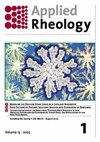Predictions of the shear modulus of cheese, a soft matter approach
IF 1.8
4区 工程技术
Q1 MECHANICS
引用次数: 4
Abstract
Abstract The rheological and structural properties of cheese govern many physical processes associated with cheese such as slumping, slicing and melting. To date there is no quantitative model that predicts shear modulus, viscosity or any other rheological property across the entire range of cheeses; only empirical fits that interpolate existing data. A lack of a comprehensive model is in part due to the many variables that can affect rheology such as salt, pH, calcium levels, protein to moisture ratio, age and temperature. By modelling the casein matrix as a series core-shell nano particles assembled from calcium and protein these variables can be reduced onto a simpler two-dimensional format consisting of attraction and equivalent hard sphere volume fraction. Approximating the interaction between core-shell nano particles with a Mie potential enables numerical predictions of shear moduli. More qualitatively, this two-dimensional picture can be applied quite broadly and captures the viscoelastic behaviour of soft and hard cheeses as well as their melting phenomena.预测奶酪的剪切模量,一种软物质方法
奶酪的流变学和结构特性决定了奶酪的塌缩、切片和融化等物理过程。迄今为止,没有定量模型预测剪切模量,粘度或任何其他流变性能在整个范围的奶酪;只有经验拟合,插入现有的数据。缺乏一个全面的模型,部分原因是由于许多变量会影响流变,如盐、pH值、钙水平、蛋白质与水分的比例、年龄和温度。通过将酪蛋白基质建模为一系列由钙和蛋白质组装而成的核壳纳米颗粒,这些变量可以简化为由吸引力和等效硬球体积分数组成的更简单的二维格式。用Mie势近似核壳纳米粒子之间的相互作用使剪切模量的数值预测成为可能。更定性地说,这张二维图可以应用得很广泛,可以捕捉软奶酪和硬奶酪的粘弹性行为以及它们的融化现象。
本文章由计算机程序翻译,如有差异,请以英文原文为准。
求助全文
约1分钟内获得全文
求助全文
来源期刊

Applied Rheology
物理-力学
CiteScore
3.00
自引率
5.60%
发文量
7
审稿时长
>12 weeks
期刊介绍:
Applied Rheology is a peer-reviewed, open access, electronic journal devoted to the publication in the field of applied rheology. The journal provides the readers with free, instant, and permanent access to all content worldwide; and the authors with extensive promotion of published articles, long-time preservation, language-correction services, no space constraints and immediate publication.
 求助内容:
求助内容: 应助结果提醒方式:
应助结果提醒方式:


